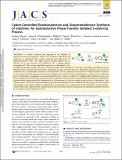Files in this item
Cation-controlled enantioselective and diastereoselective synthesis of indolines : an autoinductive phase-transfer initiated 5-endo-trig process
Item metadata
| dc.contributor.author | Sharma, Krishna | |
| dc.contributor.author | Wolstenhulme, Jamie R. | |
| dc.contributor.author | Painter, Phillip P. | |
| dc.contributor.author | Yeo, David | |
| dc.contributor.author | Grande-Carmona, Francisca | |
| dc.contributor.author | Johnston, Craig P. | |
| dc.contributor.author | Tantillo, Dean J. | |
| dc.contributor.author | Smith, Martin D. | |
| dc.date.accessioned | 2019-02-07T13:30:05Z | |
| dc.date.available | 2019-02-07T13:30:05Z | |
| dc.date.issued | 2015-10-21 | |
| dc.identifier | 256705115 | |
| dc.identifier | 3e503314-542c-4b3b-8eba-037b714f3d93 | |
| dc.identifier | 84945546527 | |
| dc.identifier.citation | Sharma , K , Wolstenhulme , J R , Painter , P P , Yeo , D , Grande-Carmona , F , Johnston , C P , Tantillo , D J & Smith , M D 2015 , ' Cation-controlled enantioselective and diastereoselective synthesis of indolines : an autoinductive phase-transfer initiated 5-endo-trig process ' , Journal of the American Chemical Society , vol. 137 , no. 41 , pp. 13414-13424 . https://doi.org/10.1021/jacs.5b08834 | en |
| dc.identifier.issn | 0002-7863 | |
| dc.identifier.other | crossref: 10.1021/jacs.5b08834 | |
| dc.identifier.other | ORCID: /0000-0003-2459-1872/work/51261134 | |
| dc.identifier.uri | https://hdl.handle.net/10023/17014 | |
| dc.description | The European Research Council has provided financial support under the European Community’s Seventh Framework Programme (FP7/2007-2013)/ERC grant agreement no. 259056. We are grateful to EPSRC and Pfizer for an award (to CPJ, EP/G041628/1), and the Tata foundation for a scholarship (to K.S.). We also acknowledge computational support from the NSF’s XSEDE program. | en |
| dc.description.abstract | A catalytic enantioselective approach to the synthesis of indolines bearing two asymmetric centers, one of which is all-carbon and quaternary, is described. This reaction proceeds with high levels of diastereoselectivity (>20:1) and high levels of enantioselectivity (up to 99.5:0.5 er) in the presence of CsOH·H2O and a quinine-derived ammonium salt. The reaction most likely proceeds via a delocalized 2-aza-pentadienyl anion that cyclizes either by a suprafacial electrocyclic mechanism, or through a kinetically controlled 5-endo-trig Mannich process. Density functional theory calculations are used to probe these two mechanistic pathways and lead to the conclusion that a nonpericyclic mechanism is most probable. The base-catalyzed interconversion of diastereoisomeric indolines in the presence of certain quaternary ammonium catalysts is observed; this may be rationalized as a cycloreversion–cyclization process. Mechanistic investigations have demonstrated that the reaction is initiated via a Mąkosza-like interfacial process, and kinetic analysis has shown that the reaction possesses a significant induction period consistent with autoinduction. A zwitterionic quinine-derived entity generated by deprotonation of an ammonium salt with the anionic reaction product is identified as a key catalytic species and the role that protonation plays in the enantioselective process outlined. We also propose that the reaction subsequently occurs entirely within the organic phase. Consequently, the reaction may be better described as a phase-transfer-initiated rather than a phase-transfer-catalyzed process; this observation may have implications for mechanistic pathways followed by other phase-transfer-mediated reactions. | |
| dc.format.extent | 3154260 | |
| dc.language.iso | eng | |
| dc.relation.ispartof | Journal of the American Chemical Society | en |
| dc.subject | QD Chemistry | en |
| dc.subject | DAS | en |
| dc.subject.lcc | QD | en |
| dc.title | Cation-controlled enantioselective and diastereoselective synthesis of indolines : an autoinductive phase-transfer initiated 5-endo-trig process | en |
| dc.type | Journal article | en |
| dc.contributor.institution | University of St Andrews. School of Chemistry | en |
| dc.identifier.doi | 10.1021/jacs.5b08834 | |
| dc.description.status | Peer reviewed | en |
This item appears in the following Collection(s)
Items in the St Andrews Research Repository are protected by copyright, with all rights reserved, unless otherwise indicated.

